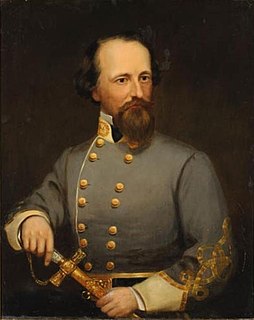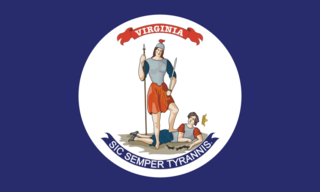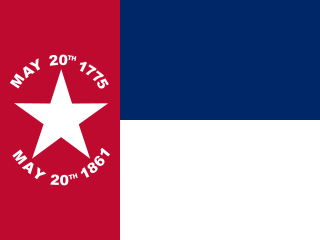
Alfred Moore Scales was a North Carolina state legislator, Confederate general in the American Civil War, and the 45th Governor of North Carolina from 1885 to 1889.

James Johnston Pettigrew was an American author, lawyer, and soldier. He served in the army of the Confederate States of America, fighting in the 1862 Peninsula Campaign and played a prominent role in the Battle of Gettysburg. Despite starting the Gettysburg Campaign commanding a brigade, Pettigrew took over command of his division after the division's original commander Henry Heth was wounded. In this role, Pettigrew was one of three division commanders in the disastrous assault known as Pickett's Charge on the final day of Gettysburg. He was badly wounded during the assault and was later mortally wounded during a Union attack while the Confederates retreated to Virginia near Falling Waters, West Virginia, dying several days later.
The Philadelphia Brigade was a Union Army brigade that served in the American Civil War. It was raised primarily in the city of Philadelphia, Pennsylvania, with the exception of the 106th regiment which contained men from Lycoming and Bradford counties.

James Dearing was a Confederate States Army officer during the American Civil War who served in the artillery and cavalry. Dearing entered West Point in 1858 and resigned on April 22, 1861, when Virginia seceded from the Union. Dearing was mortally wounded at the Battle of High Bridge during the Appomattox Campaign of 1865, making him one of the last officers to die in the war. Despite serving as a commander of a cavalry brigade and using the grade of brigadier general after he was nominated to that grade by Confederate President Jefferson Davis, Dearing did not officially achieve the grade of brigadier general because the Confederate Senate did not approve his nomination. His actual permanent grade was colonel.

The 26th North Carolina Infantry Regiment was an infantry regiment of the Confederate States Army during the American Civil War. The regiment was composed of ten companies that came from various counties across North Carolina and Virginia. It is famous for being the regiment with the largest number of casualties on both sides during the war.

The 105th Pennsylvania Volunteer Infantry was an infantry regiment which served in the Union Army during the American Civil War. Among the regiment's early recruits was future United States Congressman Albert C. Thompson.
Battery I, 1st Michigan Light Artillery Regiment was an artillery battery from Michigan that served in the Union Army during the American Civil War.
A. P. Hill's Light Division was an infantry division in General Robert E. Lee's Confederate Army of Northern Virginia during the American Civil War. Originally including six brigades, the division's first commander starting May 27, 1862 was then Major General A. P. Hill. Major Generals William Dorsey Pender and Cadmus M. Wilcox commanded a reorganized Light Division in the Army of Northern Virginia after Hill's promotion to corps command and Pender's death at the Battle of Gettysburg, respectively.

Henry King Burgwyn, Jr. was a Confederate colonel in the American Civil War killed at the Battle of Gettysburg.

James Keith "Jimmy" Marshall was a Confederate Army officer during the American Civil War. Marshall commanded the wounded J. Johnston Pettigrew's brigade during Pickett's Charge at the Battle of Gettysburg and died during the assault.

The 24th Virginia Infantry Regiment was an infantry regiment raised in southwestern Virginia for service in the Confederate States Army during the American Civil War. It fought throughout the conflict, mostly with the Army of Northern Virginia. The 24th Virginia's most prominent field officers were Colonels Jubal A. Early and William R. Terry; Lieutenant Colonels Peter Hairston, Jr. and Richard L. Maury; and Majors William W. Bentley, Joseph A. Hambrick, and J.P. Hammet.

The 15th Alabama Infantry Regiment was a Confederate volunteer infantry unit from the state of Alabama during the American Civil War. Recruited from six counties in the southeastern part of the state, it fought mostly with Robert E. Lee's Army of Northern Virginia, though it also saw brief service with Braxton Bragg and the Army of Tennessee in late 1863 before returning to Virginia in early 1864 for the duration of the war. Out of 1958 men listed on the regimental rolls throughout the conflict, 261 are known to have fallen in battle, with sources listing an additional 416 deaths due to disease. 218 were captured, 66 deserted and 61 were transferred or discharged. By the end of the war, only 170 men remained to be paroled.

The 18th North Carolina Infantry Regiment was an infantry regiment raised in North Carolina for service in the Confederate States Army during the American Civil War. It fought mostly with the Army of Northern Virginia.
The 12th New Jersey Infantry Regiment was a Union Army regiment from New Jersey that fought in the American Civil War.
The 1st Missouri Infantry was an infantry regiment that served in the Confederate States Army during the American Civil War. Originally commanded by Colonel John S. Bowen, the regiment fought at the Battle of Shiloh, where it was engaged near the Peach Orchard on April 6, 1862. On April 7, during the Union counterattacks at Shiloh, the regiment was instrumental in preventing the Washington Artillery from being captured. The regiment was next engaged at the Second Battle of Corinth, where it outflanked several Union positions. On the second day at Corinth, the regiment was only minimally engaged. On November 7, the 1st Missouri Infantry was combined with the 4th Missouri Infantry to form the 1st and 4th Missouri Infantry (Consolidated), as a result of heavy battle losses in both regiments.

The 20th North Carolina Infantry Regiment was an infantry regiment in the Confederate States Army. It was part of the Army of Northern Virginia for most of the war.

The 1st North Carolina Infantry Regiment was an infantry regiment of the Confederate States Army during the American Civil War. As part of the Army of Northern Virginia it fought in the Eastern Theater until the surrender at Appomattox.
The 44th North Carolina Infantry Regiment was a unit of the Confederate States Army during the American Civil War.

Carl Jacob Hammarsköld (1833–1884), also known as Charles J. Hammarskold, was a member of the prominent Hammarskjöld family, who in 1850 followed his father to the United States. He became an ironmaster and U.S. Postmaster in North Carolina. When the American Civil War began, he was commissioned in the Confederate States Army, resigning as lieutenant colonel after the Seven Days Battles. Hammarsköld returned to his old homeland in 1863, where he made a successful, albeit short, career as a railwayman, dying at the age of 50.
The 2nd Missouri Infantry Regiment was an infantry regiment that served in the Confederate States Army during the American Civil War. Organized on January 16, 1862, the regiment first saw major action at the Battle of Pea Ridge on March 7 and 8, 1862. After Pea Ridge, the regiment was transferred across the Mississippi River, fighting in the Battle of Farmington, Mississippi on May 9. The unit missed the Battle of Iuka in September, but was heavily engaged at the Second Battle of Corinth on October 3 and 4. The regiment helped drive in a Union position on October 3. On October 4, the 2nd Missouri Infantry, along with the rest of Colonel Elijah Gates' brigade, captured a fortification known as Battery Powell, but were forced to retreat by Union reinforcements.















